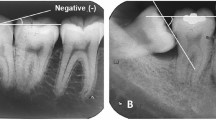Abstract
Objectives
The objective of this study was to clarify the discrepancy of pathology between earlier and recent studies related to third molars in the elderly persons. Evidence of third molars in the elders is limited. Earlier radiographic studies show rather few pathologic findings related to third molars. Recently, clinical studies have shown totally different numbers for pathology.
Materials and methods
Participants were drawn from the population-based Helsinki Aging Study. The study included panoramic radiographs of 293 persons (mean age 79 years, SD ± 3.9 years). We examined the prevalence of third molars and associated pathology and used the chi-squared test to perform the statistical analysis.
Results
Of the whole group of elderly persons, 19 % had at least one third molar. The usual dental diseases, caries and periodontal pathology (80 and 33 %, respectively), were common in the third molars. The surviving third molar most often appeared in the mandible (P < 0.01), in men (P < 0.05), in the mesioangular position (P < 0.05), and far from the mandibular canal (P < 0.001). Pathology was present in every third molar, although the proportion of serious pathology (i.e., cyst and tumor), accounted for only 2 % of third molars.
Conclusions
Although serious pathology related to third molars in the elders is uncommon, universal biofilm diseases (caries and periodontal pathology) widely affect third molars as well as all other teeth.
Clinical relevance
Because all of the surviving third molars of the elders were diseased, it would be justifiable to extract these teeth at a younger age.



Similar content being viewed by others
References
Suominen-Taipale L, Nordblad A, Vehkalahti M (2008) Edentulous and number of teeth. In: Suominen-Taipale L, Nordblad A, Vehkalahti M, Aromaa A (ed) Oral health in the Finnish adult population. Health 2000 Survey. Publications of the National Public Health Institute B25/2008. Helsinki, pp 39–43. http://www.terveys2000.fi/julkaisut/oral_health.pdf. Accessed 21 Feb 2014
Ventä I, Ylipaavalniemi P, Turtola L (2004) Clinical outcome of third molars in adults followed during 18 years. J Oral Maxillofac Surg 62:182–185
Hugoson A, Kugelberg CF (1988) The prevalence of third molars in a Swedish population. An epidemiological study. Community Dent Health 5:121–138
Fisher EL, Moss KL, Offenbacher S, Beck JD, White RP Jr (2010) Third molar caries experience in middle-aged and older Americans: a prevalence study. J Oral Maxillofac Surg 68:634–640
Eliasson S, Heimdahl A, Nordenram Å (1989) Pathological changes related to long-term impaction of third molars. A radiographic study. Int J Oral Maxillofac Surg 18:210–212
Stanley HR, Alattar M, Collett WK, Stringfellow HR Jr, Spiegel EH (1988) Pathological sequelae of “neglected” impacted third molars. J Oral Pathol 17:113–117
Garaas R, Moss KL, Fisher EL et al (2011) Prevalence of visible third molars with caries experience or periodontal pathology in middle-aged and older Americans. J Oral Maxillofac Surg 69:463–470
Siukosaari P, Ajwani S, Ainamo A, Wolf J, Närhi T (2012) Periodontal health status in the elderly with different levels of education: a 5-year follow-up study. Gerodontology 29:e170–178
Ahlqwist M, Gröndahl H-G (1991) Prevalence of impacted teeth and associated pathology in middle-aged and older Swedish women. Community Dent Oral Epidemiol 19:116–119
Huang H, Mercier P (1992) Asymptomatic impacted teeth in edentulous jaws undergoing preprosthetic surgery. A long-term evaluation. Int J Oral Maxillofac Surg 21:147–149
Moss KL, Beck JD, Mauriello SM, Offenbacher S, White RP Jr (2007) Third molar periodontal pathology and caries in senior adults. J Oral Maxillofac Surg 65:103–108
Blakey GH, Marciani RD, Haug RH, Phillips C, Offenbacher S, Pabla T, White RP Jr (2002) Periodontal pathology associated with asymptomatic third molars. J Oral Maxillofac Surg 60(11):1227–1233
Nunn ME, Fish MD, Carcia RI, Kaye EK, Figueroe R, Gohel A, Ito M, Lee HJ, Williams DE, Miyamoto T (2013) Retained asymptomatic third molars and risk for second molar pathology. J Dent Res 92(12):1095–1099
Hinds EC, Frey KF (1980) Hazards of retained third molars in older persons: report of 15 cases. J Am Dent Assoc 101:246–250
Girod SC, Gerlach KL, Krueger G (1993) Cysts associated with long-standing impacted third molars. Int J Oral Maxillofac Surg 22:110–112
Osaki T, Nomura Y, Hirota J, Yoneda K (1995) Infections in elderly patients associated with impacted third molars. Oral Surg Oral Med Oral Pathol Oral Radiol Endod 79:137–141
Senpuku H, Sogame A, Inoshita E, Tsuha Y, Miyazaki H (2003) Systemic diseases in association with microbial species in oral biofilm from elderly requiring care. Gerontology 49:301–309
Yamaoka M, Furusawa K, Tambo A, Imai S (1997) Remaining mandibular third molars in an adult population. J Oral Rehab 24:895–898
National Institute for Health and Care Excellence (2000) Guidance on the extraction of wisdom teeth. Technology Appraisals (TA1). http://www.nice.org.uk/guidance/ta1. Accessed 5 December 2014
Scottish Intercollegiate Guideline Network (2000) Management of unerupted and impacted third molar teeth. Publication No: 43. http://www.sign.ac.uk/guidelines/fulltext/43/index.html. Accessed 5 December 2014
Acknowledgments
We are deeply indebted to Professor Anja Ainamo who started the oral part of the Helsinki Aging Study and made it possible to use the described material for the present study.
Ethical standards
The Ethics Committee of the Institute of Dentistry, University of Helsinki, approved the study protocol. The study also complies with the Helsinki Declaration, and each subject was informed about the study protocol and provided their written informed consent.
Conflict of interest
The authors declare that they have no conflict of interest.
Author information
Authors and Affiliations
Corresponding author
Rights and permissions
About this article
Cite this article
Ventä, I., Kylätie, E. & Hiltunen, K. Pathology related to third molars in the elderly persons. Clin Oral Invest 19, 1785–1789 (2015). https://doi.org/10.1007/s00784-014-1395-y
Received:
Accepted:
Published:
Issue Date:
DOI: https://doi.org/10.1007/s00784-014-1395-y




